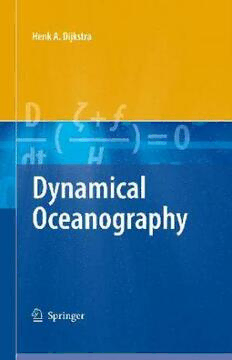
Dynamical Oceanography PDF
Preview Dynamical Oceanography
Dynamical Oceanography Henk A. Dijkstra Dynamical Oceanography HenkA.Dijkstra Univ.Utrecht Inst.MarineandAtmospheric Research Princetonplein5 3584CCUtrecht Netherlands [email protected] ISBN:978-3-540-76375-8 e-ISBN:978-3-540-76376-5 LibraryofCongressControlNumber:2007941789 (cid:2)c 2008Springer-VerlagBerlinHeidelberg Thisworkissubjecttocopyright. Allrightsarereserved,whetherthewholeorpartofthematerialis concerned,specificallytherightsoftranslation,reprinting,reuseofillustrations,recitation,broadcasting, reproductiononmicrofilmorinanyotherway,andstorageindatabanks.Duplicationofthispublication orpartsthereofispermitted onlyundertheprovisions oftheGermanCopyright LawofSeptember9, 1965,initscurrentversion,andpermissionforusemustalwaysbeobtainedfromSpringer.Violationsare liabletoprosecutionundertheGermanCopyrightLaw. Theuseofgeneraldescriptivenames,registerednames,trademarks,etc.inthispublicationdoesnotimply, evenintheabsenceofaspecificstatement,thatsuchnamesareexemptfromtherelevantprotectivelaws andregulationsandthereforefreeforgeneraluse. Coverdesign:deblik,Berlin Printedonacid-freepaper 9 8 7 6 5 4 3 2 1 springer.com Preface Thistextprovidesanintroductiontothetheoryofthelarge-scaleoceancircula- tion. Thereareexcellenttextbooksonphysicaloceanography(PondandPickard, 1983; OU-staff, 1989; Pickard and Emery, 1990; Tomczak and Godfrey, 1994; Pedlosky,1996;Knaus,1997),andgeophysicalfluiddynamics(Pedlosky,1987; Cushman-Roisin,1994;Salmon,1998;Pedlosky,2003;McWilliams,2006;Val- lis,2006). However,foratypicalcoursewhereonewantstofocusontheocean circulation only at a challenging level for physics and mathematics students, a combinationofmaterialfromthesebooksisneeded. Thistextisanattemptinto thisdirectionwhichhasresultedinabookonalevelbetweenPondandPickard (1983)andPedlosky(1996)withmuchbasicmaterialfromPedlosky(1987). Thebookconsistsoffourparts. InpartI(chapters1-4)abriefintroduction isgivenintotheoceancirculationandthegoverningequationsofoceanflows. In addition, concepts are introduced that are necessary to describe and understand thebehavioroflarge-scaleoceancurrents. InpartII(chapters5-10),thetheory ofthemidlatitudewind-drivenoceancirculationispresented.Consideringmodel development, there is a top-down approach and reduced equations are derived usingasymptoticmethodsandscaling. PartIII(chapters11-12)focussesonthe understanding of equatorial currents and El Nin˜o. In the last part IV, chapters 13 - 16, basic theory of planetary scale flows is presented, covering topics as the thermocline problem, the Antarctic Circumpolar Current, the Arctic Ocean circulationandthestabilityofthethermohalinecirculation. Additionalmaterialbothinbroadening(indicatedbyaB)anddeepening(indi- catedbyaD)ofthetopicsdiscussedisindicatedinseparatedblocks. Attheend of each chapter several exercises are formulated and pointers to these exercises appearintheleftmarginofthemaintext. Manyoftheseexercisesareaimedto further develop methodological skills and to become familiar with the physical concepts. Newmaterialisintroducedinonlyafewoftheseexercises. Solutions totheexercisesareavailableatthewebsiteofthebookat http://www.phys.uu.nl/∼dijkstra/DO v vi DYNAMICAL OCEANOGRAPHY It should be possible to go through this text with an elementary knowledge ofmathematicsandphysics. MathematicaltechniquessuchasGreen’sfunctions and the method of inner and outer expansions are presented using elementary examples. The use of proper asymptotic methods requires dimensionless equa- tionswhileforunderstandingofphysicalconceptsdimensionalquantitiesarebest suited. ThroughoutthetextIthereforehaveusedastrict*-subscriptnotationto indicatedimensionaldependentquantitiesexceptinchapterswhereonlydimen- sionalquantitiesareused.Inthiswayreducedmodelequations,suchasthequasi- geostrophicmodelinchapter5,arederivedusingdimensionlessquantitiesandthe dimensionalresultisstatedafterwards. Resultsandmodelswhicharefrequently usedintheliteraturearepresentedinseparateboxesforeasyreference.Important issuescanalsobefoundintheSummaryboxesattheendofeachchapter. IhopethatstudentsandinterestedresearcherswilllikethewayIhavechosen topresentthematerialandfindthisbookausefuladdition. SEPTEMBER2007,UTRECHT To my parents, Klaas and Sjoukje Dijkstra Acknowledgments The book is based on the (mandatory) course on Dynamical Oceanography whichIgaveforseveralyearsattheInstituteforMarineandAtmosphericresearch Utrecht (IMAU) which is within the Department of Physics and Astronomy of UtrechtUniversity,theNetherlands.IwanttothankWilldeRuijterforhissupport of all my activities at the IMAU and for his efforts to make the IMAU such a pleasantandinterestingplacetowork. Hiscommentsonthechapters1to6have been very valuable and for the material in the chapters 1 to 3, I have benefitted fromnotesofhiscourse‘IntroductiontoPhysicalOceanography’. MyformerPh.D.studentLianketeRaaisthankedfortheefficientcollabora- tionduringthecoursesonDynamicalOceanographyatIMAU.Hercommentson the chapters 13 and 14 are gratefully acknowledged as well as her input on the exercises. Leela Frankcombe read the entire manuscript and corrected much of the text and many equations. Ole Anders Nøst (Norsk Polar Institute, Norway) kindlyprovidedfilesoffiguresforchapter15. MypublishersatSpringer(firstGeertJanGeraedsandlaterChrisBendall)are thankedfortheirstimulustocompletethisbook. LaurenceMysakisthankedfor hisusefulcommentsonpartsofanearlyversionofthetextandforsuggestingto includeachapterontheArcticOceancirculation. ThemanystudentswhohavebeenactivelyinvolvedintheIMAUcourseson DynamicalOceanographyovertheyearsarethankedfortheirpatience, enthusi- asm and input. Finally, my wife Julia contributed to the writing of this book in herownspecialway.Ithankherforherpatienceandunderstanding. ix Contents Preface v Acknowledgments ix Part I Introduction 1. A FIRST IMPRESSION 3 1.1 The ocean basins 4 1.2 Exploration of the oceans 7 1.2.1 A tiny bit of history 7 1.2.2 The modern era 9 1.3 Characteristics of seawater 10 1.3.1 Salinity 10 1.3.2 The surface distribution of temperature and salinity 11 1.3.3 T - S diagrams and water masses 13 1.3.4 Static stability 16 1.4 Exercises on chapter 1 23 2. PRESENT OCEAN CIRCULATION 27 2.1 Forcing fields 28 2.1.1 Wind stress 28 2.1.2 Heat flux 28 2.1.3 Freshwater flux 30 2.2 Ocean circulation 33 2.2.1 Surface circulation 33 2.2.2 Thermohaline circulation 35 2.2.3 Heat and freshwater transport 36 2.3 Oceans and climate 39 2.4 Motivating problems and approach 42 2.4.1 Western boundary currents 42 2.4.2 Internal variability of ocean flows 42 xi xii DYNAMICAL OCEANOGRAPHY 2.4.3 Special equatorial phenomena 44 2.4.4 Phenomena on the planetary scale 44 2.5 Exercises on chapter 2 47 3. MATHEMATICAL DESCRIPTION 51 3.1 A priori scales 52 3.1.1 Geometry 52 3.1.2 Coriolis acceleration 53 3.1.3 Stratification 56 3.1.4 Mixing of momentum, heat and salt 57 3.1.5 Ratio of scales 59 3.2 Large-scale balances 60 3.2.1 Equations of motion 61 3.2.2 Spherical coordinates 62 3.2.3 Boundary conditions 63 3.3 Dominant balances 65 3.4 Exercises on chapter 3 68 4. VORTICITY 71 4.1 The vorticity equation 72 4.2 Vorticity transport 73 4.2.1 Vortex stretching and tilting 73 4.2.2 Baroclinic vorticity production 74 4.2.3 Diffusion of vorticity 76 4.3 Potential vorticity 77 4.4 Shallow-water equations 79 4.4.1 Hydrostatic equilibrium 79 4.4.2 Inertial flows 81 4.5 Exercises on chapter 4 86 Part II Midlatitude circulation 5. WIND-DRIVEN CIRCULATION 91 5.1 The North Atlantic surface circulation 92 5.2 The barotropic circulation on the β-plane 94 5.2.1 The β-plane approximation 94 5.2.2 Boundary conditions 97 5.2.3 Model equations 98 5.3 Stationary solutions 99 5.3.1 The geostrophic flow 103 5.3.2 The bottom Ekman layer 105 5.3.3 The free surface Ekman layer 110 5.3.4 Continuity of the vertical velocity 113
